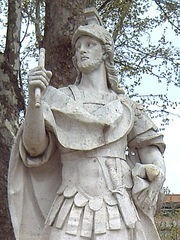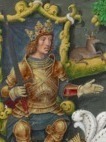Arbre généalogique Snelder - Versteegh » King Iñigo Arista of Pamplona (790-852)
Données personnelles King Iñigo Arista of Pamplona
Source 1- Il est né en l'an 790 dans Bigorre, Spain.
- Il est décédé en l'an 852 dans Cordoba, Andalucia, Spain, il avait 62 ans.
- Un enfant de Iñigo Jiménez Arista of Pamplona
Famille de King Iñigo Arista of Pamplona
Il est marié avec Oneca Velasquez.
Ils se sont mariés
Enfant(s):
Notes par King Iñigo Arista of Pamplona
https://en.wikipedia.org/wiki/%C3%8D%C3%B1igo_Arista_of_Pamplona
Íñigo Arista (Basque: Eneko, Arabic: ونّقه, Wannaqo, c. 790 – 851 or 852) was a Basque leader, considered the first King of Pamplona.[1][2] He is thought to have risen to prominence after the defeat of local Frankish partisans in 816, and his rule is usually dated from shortly after the defeat of a Carolingian army in 824.
He is first attested by chroniclers as a rebel against the Emirate of Córdoba from 840 until his death a decade later. Remembered as the nation's founder, he would be referred to as early as the 10th century by the nickname "Arista",[3] coming either from Basque Aritza (Haritza/Aiza, literally 'the oak', meaning 'the resilient') or Latin Aresta ('the considerable').[4]
The origin of Íñigo Arista is obscure. There is even disagreement regarding the name of his father. A charter preserved at Leyre describes him as Enneco ... filius Simeonis (Íñigo son of Jimeno) and another Leyre document reports the obituary of Enneco Garceanes, que fuit vulgariter vocas Areista (Íñigo Garcés [son of García], who is commonly called Arista). Many later historians have followed one or the other of these, but the reliability of both are questioned due to the possibility of later corruption or forgery.
Eleventh century chroniclers Ibn Hayyan, who calls him and his brother both ibn Wannaqo (Arabic: بن ونّقه, Íñiguez), and Al-Udri (ibn Yannaqo) indicate that his father was likewise named Íñigo.[5] He is said by Rodrigo Jiménez de Rada (c. 1170–1247) to have been count of Bigorre, or at least to have come from there, but there is no near-contemporary evidence of this.[6]
It has been speculated that he was kin to García Jiménez, who in the late 8th century succeeded his father Jimeno 'the Strong' in resisting Carolingian expansion into Vasconia. A second dynasty of Pamplona monarchs that would supplant his, the Jimena, are usually made to be related to him.[7]
The name of Íñigo's mother is unknown (she is sometimes called Onneca, without foundation) but it is known that she also married local muwallad lord Musa ibn Fortun ibn Qasi, by him having a son Musa ibn Musa ibn Qasi.[a] This younger Musa would become head of the Banu Qasi, ruler of Tudela and one of the chief lords of Ebro Valley. Due to this relationship, Íñigo and his kin frequently acted in alliance with Musa ibn Musa, a relationship that allowed Íñigo to extend his influence over large territories in the Pyrenean valleys, and was also instrumental in the rebellions that would lead to Pamplona breaking with the Emirate.
The family came to power through struggles over Frankish and Córdoban influence in northern Iberia. In 799, pro-Frankish assassins murdered Mutarrif ibn Musa, governor of Pamplona, perhaps the brother of Musa ibn Musa ibn Qasi and even of Íñigo himself. Ibn Hayyan reports that in 816, Abd al-Karim ibn Abd al-Wahid ibn Mugit launched a military campaign against the pro-Frankish "Enemy of God", Velasco the Gascon (Arabic: بلشك الجلشقي, Balašk al-Ŷalašqī), Sahib of Pamplona (Arabic: صاحب بنبلونة), who had united Christian and pagan factions. They fought a three-day battle in which the pro-Córdoba faction routed their enemies and killed Velasco, along with García López, kinsman of Alfonso II of Asturias, Sancho "warrior/knight of Pamplona", and pagan warrior "Ṣaltān". This defeat of the pro-Frankish force appears to have allowed the anti-Frankish Íñigo to come to power.
In 820, Íñigo is said to have intervened in the County of Aragon, ejecting a Frankish vassal, count Aznar I Galíndez, in favor of García el Malo (the Mean), who would become Íñigo's son-in-law. In 824, a Carolingian force led by counts Aeblus and Aznar Sánchez made an expedition against Pamplona, but were defeated in the second Battle of Roncesvalles.[9]
Traditionally, this battle is portrayed as resulting in the crowning of Íñigo as "King of Pamplona", but there is no direct evidence of his involvement in the battle or his crowning thereafter, and he is referred to by Arabic chroniclers with the same title as given Velasco, "Lord of Pamplona". His realm would continually play Muslim and Christian against themselves and each other to maintain independence against the outside powers.
In 840 Íñigo's lands were attacked by Abd Allah ibn Kulayb, wali of Zaragoza, leading his half-brother, Musa ibn Musa, into rebellion.[10] Íñigo's son García acted as regent, in concert with Íñigo's warrior brother Fortún Íñiguez (Arabic: ÙرتÙ٠ب٠ÙÙÙÙÙ, FortÅ«n ibn Wannaqo), who was also half-brother of Musa, and they joined Musa in an uprising against the Emirate of Córdoba. Abd-ar-Rahman II, emir of Córdoba, launched reprisal campaigns in the succeeding years.
In an 843 battle, Fortún Íñiguez was killed, and Musa unhorsed and forced to escape on foot, while Íñigo and his son Galindo escaped with wounds and several noblemen, most notably Velasco Garcés, defected to Abd-ar-Rahman. The subsequent year, Íñigo's own son, Galindo Íñiguez, and Musa's son Lubb ibn Musa went over to Córdoba, and Musa was forced to submit. Following a brief campaign in 845, a general peace was achieved. In 850, Mūsā again rose in open rebellion, supported by Pamplona,[10] and envoys of Induo (thought to be Íñigo) and Mitio,[b] "Dukes of the Navarrese", were received at the French court.
Íñigo died in the Muslim year 237 A.H., which is late 851 or early 852, and was succeeded by his son García Íñiguez who was already governing the kingdom during his father's long illness prior to his death.[9][c]
During the lifetime of Íñigo, the existence of several monasteries is attested across Navarre, when the Cordovan priest Eulogius had to stay in the area (848). In a letter written to Wiliesind, not only does Eulogius reveal that the Basque leader was a christicola princeps but he provides the names of three monasteries not far from Pamplona: Siresa, St. Zacharias and Leyre.
The iconic monastery of Leyre, founded in the 9th century[11] and claimed later to be founded by the king of Pamplona, was fostered by granting lands and estates to it. A document in the archives of the monastery shows that in 842, Íñigo bestowed the town and lands of Yesa on Leyre ("Ego rex Eneco concedo..."), although the authenticity of the document recording this grant is disputed. Íñigo himself is reported to have been buried in the monastery after his death in 851/852.https://en.wikipedia.org/wiki/%C3%8D%C3%B1igo_Arista_of_Pamplona
The name of the wife (or wives) of Íñigo is not reported in contemporary records, although sources from centuries later assign her the name of Toda or Onneca.[12] There is also scholarly debate regarding her derivation, some hypothesizing that she was daughter of Velasco, lord of Pamplona (killed 816), and others making her kinswoman of Aznar I Galí;ndez.[d] He was father of the following known children:
- Assona Íñiguez, who married her father's half-brother, Musa ibn Musa ibn Fortun ibn Qasi, lord of Tudela and Huesca
- García Íñiguez, regent and then Íñigo's successor as 'king'.
- Galindo Íñiguez, fled to Córdoba where he was friend of Eulogius of Córdoba. The Musa ibn Galind, Amil of Huesca in 860, assassinated in 870, was apparently his son.[13]
- a daughter who married Count García el Malo (the Mean) of Aragón.[9]
Barre chronologique King Iñigo Arista of Pamplona
 grand-parents
grand-parents
 parents
parents
 frères/soeurs
frères/soeurs
 enfants
enfants
Ancêtres (et descendants) de Iñigo Arista of Pamplona
Iñigo Arista of Pamplona  | ||||||||||||||||||||||||||||||||||
Oneca Velasquez | ||||||||||||||||||||||||||||||||||
Les sources
- WikiTree, via https://www.myheritage.nl/research/colle...
Iñigo Iñiguez Arista de Pamplona (geboren Pamplona)<br>Geslacht: Man<br>Geboorte: 790 - Bigorre, Spain<br>Overlijden: 852 - Cordoba, Andalucia, Spain<br>Vader: Iñigo Jiménez Arista de Pamplona (geboren Pamplona)<br>Echtgenote: Oneca de Pamplona (geboren Velasquez)<br>Kind: García Iñiquez de Pamplona (geboren Pamplona)
www.wikitree.com
Sur le nom de famille Of Pamplona
- Afficher les informations que Genealogie Online a concernant le patronyme Of Pamplona.
- Afficher des informations sur Of Pamplona sur le site Archives Ouvertes.
- Trouvez dans le registre Wie (onder)zoekt wie? qui recherche le nom de famille Of Pamplona.
Roel Snelder, "Arbre généalogique Snelder - Versteegh", base de données, Généalogie Online (https://www.genealogieonline.nl/stamboom-snelder-versteegh/I507447.php : consultée 13 mai 2024), "King Iñigo Arista of Pamplona (790-852)".
